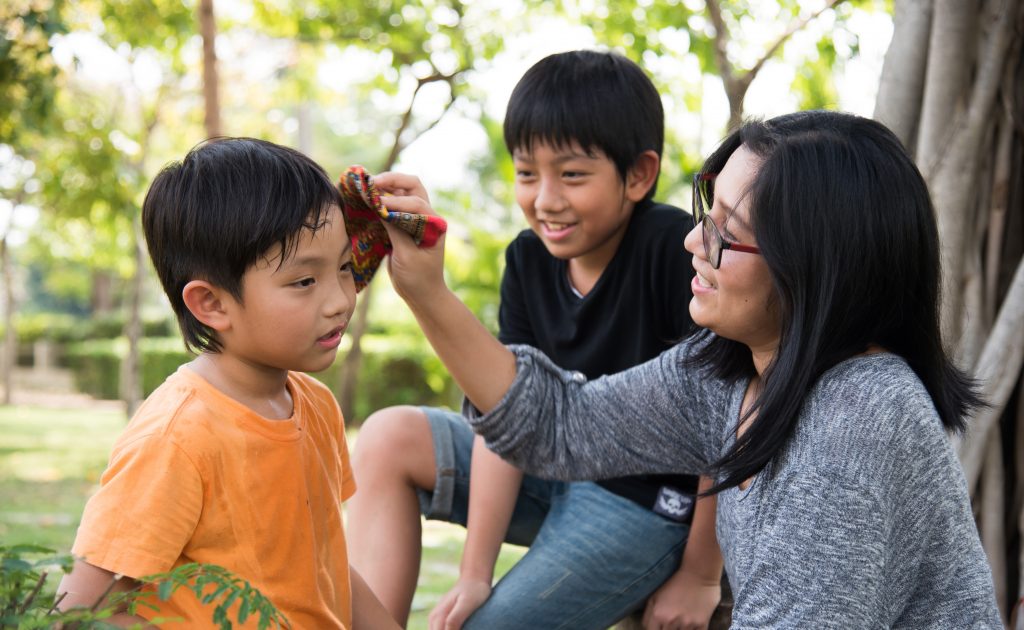Kids and Heat

Summer is here which is prime time for summer camps, vacations and practice for high school sports. These activities among many others put kids outside in the scorching heat. What most people don’t know is that kids of all ages are actually more vulnerable to heat-related illnesses than adults. Kids are at higher risk because they have a larger surface area in comparison to their total weight and because they tend to be less aware of the risks the heat brings when they’re playing and having fun.
Before we go on, it’s important to keep in mind that heat-related illnesses are due to external heat and are not the same as having a fever. Any elevated body temperature from hyperthermia, or extreme heat, is due to a reaction to the heat in the environment, and not an immune system response to an infection. DO NOT give a child with an elevated internal body temperature due to a heat-related illness fever reducing medications like Tylenol. Additionally, we’re not talking about potential skin damage as a result of sun exposure. It’s possible to have a heat-related illness and not have a sunburn and vice versa.
So what is heat related illness?
There are three primary forms of heat-related illnesses, and each increase with severity if not treated at the lower level.
Heat Cramps: An early sign of a progressing heat illness are muscle cramps. These cramps are usually due to exercise in extreme heat combined with not drinking enough fluids.
Heat Exhaustion: More severe than heat cramps, heat exhaustion will also cause an elevation in body temperature. Remember, this elevated internal temperature is not due to a typical fever. Other symptoms include sweating, fast yet weak pulse, muscle cramps, cold clammy skin, vomiting or nausea and potentially dizziness or fainting. It is important to recognize these signs early and seek treatment because exhaustion will progress to heat stroke if left untreated.
Heat Stroke: Symptoms include body temperature of up to 106 or higher along with severe confusion, headache, seizure, loss of consciousness and coma. Patients may have a fast heart beat and fast breathing, including shortness of breath. At this point patients are not able to sweat to control their body temperature. This is a life-threatening medical EMERGENCY! CALL 911 IMMEDIATELY!
How is heat-related illness treated?
As I said before the most important thing is to recognize the early symptoms so that the illness does not progress.
Heat Cramps: The treatment for heat cramps is simply resting in the shade and pushing fluids like water and electrolyte drinks. Sometimes stretching or massage can help alleviate the pain from the cramps, but this alone won’t treat the primary cause of the cramps. Once the cramps subside, hold off returning to play or activity in the heat for a few hours.
Heat Exhaustion: If your child seems to be progressing from cramps to symptoms of exhaustion, apply cool rags to the skin and go indoors for the rest of the day. Make sure they keep drinking fluids. If your child is showing signs of dehydration (dry mouth, cool finger tips, lack of urination) consider taking him/her to the nearest emergency room for IV fluids. If your child has an elevated internal body temperature DO NOT give them a fever reducer like Tylenol. Fever reducers won’t help this type of elevated internal body temperature and they could do more damage.
Heat Stroke: Once you suspect heat stroke, call 911 IMMEDIATELY! Keep your child cool until help arrives and DO NOT attempt to give fluids by mouth if he/she is starting to lose consciousness.
Giving a child suffering from heat stroke fluids is dangerous. The child could choke on the fluids if they have a seizure or become unconscious. Additionally giving fluids without the right balance of electrolytes and sodium can do more harm than good.
How can heat-related illness be prevented?
Prevention and monitoring your children carefully is extremely important when temperatures rise. Try to keep kids inside in the middle of the day during peak sun. If they are going to be outside, dress them in cool, light clothing and make sure they are wearing sunscreen. Don’t forget hats too. Have them drink fluids and hydrate all throughout the day, even when they aren’t thirsty. Water is best as sports drinks are very sugary and are not necessarily any better than water for hydration. Schedule break times for them to go indoors where it is cool or at least rest in the shade. Older kids attending sports practice should gradually start exercising outside to get in shape and acclimate to the heat prior to starting practice, but again keep a close eye on them. Once practice has started, talk to the coach about scheduling breaks and if/when practice will be cancelled due to heat.
The most important thing to take away is knowing the signs of heat related illness so that you can intervene and prevent progression.

